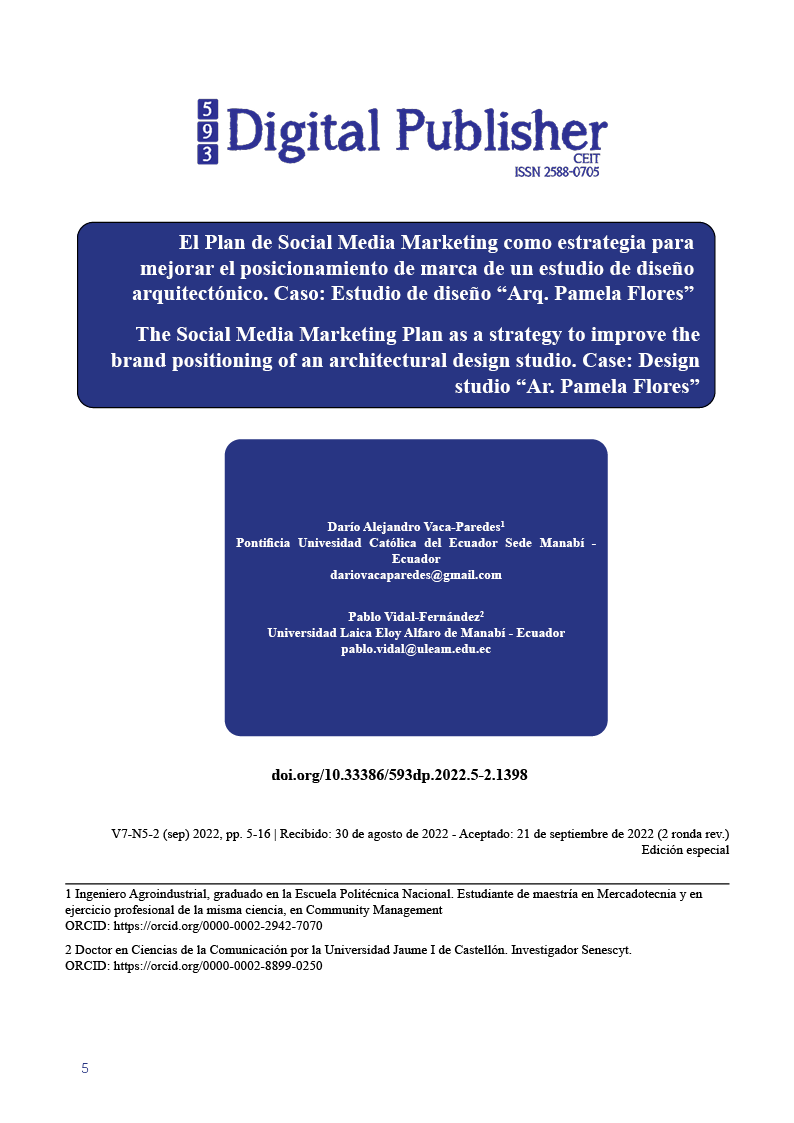The Social Media Marketing Plan as a strategy to improve the brand positioning of an architectural design studio. Case: Design studio “Ar. Pamela Flores”
Main Article Content
Abstract
Social Media Marketing is a trend on the rise, which allows new strategies to be designed that will help meet the objectives of organizations. Within the field of construction, specifically architectural design studios, a Social Media Marketing plan allows you to directly reach the customer segment through the use of social networks. The purpose of this work was to carry out a Social Media Marketing plan to improve the brand positioning of the design studio “Arq. Pamela Flores”. The study is of a mixed nature, for which surveys were carried out on the defined sample, as well as an interview with the owner of the study. The methodology of the proposed plan for this study was carried out based on 3 phases. Firstly, a diagnosis of the own Social Media and of the competition was made, then the audience and the buyer person were defined, later the social networks on which to work were selected, as well as the most suitable content and, finally, proposed a plan performance evaluation plan. It was concluded that there is a weak brand presence in social networks, as well as poor management of competition in the digital ecosystem, represent a business opportunity to generate competitive advantages through these channels (social networks) increasing the scope, notoriety and degree of influence. in the target audience. The next step will be to direct the strategy towards a sustainable increase in sales, accompanied by the development of a personal brand.
Keywords: social media marketing plan, social networks, social media, architecture and design, brand awareness
Downloads
Article Details

This work is licensed under a Creative Commons Attribution-NonCommercial-ShareAlike 4.0 International License.
1. Derechos de autor
Las obras que se publican en 593 Digital Publisher CEIT están sujetas a los siguientes términos:
1.1. 593 Digital Publisher CEIT, conserva los derechos patrimoniales (copyright) de las obras publicadas, favorece y permite la reutilización de las mismas bajo la licencia Licencia Creative Commons 4.0 de Reconocimiento-NoComercial-CompartirIgual 4.0, por lo cual se pueden copiar, usar, difundir, transmitir y exponer públicamente, siempre que:
1.1.a. Se cite la autoría y fuente original de su publicación (revista, editorial, URL).
1.1.b. No se usen para fines comerciales u onerosos.
1.1.c. Se mencione la existencia y especificaciones de esta licencia de uso.
References
Barker, M. (2015). Marketing para medios sociales: Un planteamiento estratégico. Cengage Learning Editores. https://bibliotecavirtual.puce.edu.ec/reader/marketing-para-medios-sociales-un-planteamiento-estrategico?location=24
Beltrán Mora, M. N., Parrales Carvajal, V. M., & Ledesma Álvarez, G. D. (2019). El Buyer Persona como factor clave entre las tendencias en Gestión Empresarial. Revista Científica Mundo de La Investigación y El Conocimiento, 3, 660–681.
Carrasco Ortega, M. (2020, May). Herramientas del marketing digital que permiten desarrollar presencia online, analizar la web, conocer a la audiencia y mejorar los resultados de búsqueda. Revista Perspectivas, 33–60.
Esteves, A. (2020). El impacto del COVID-19 en el mercado de trabajo de Ecuador. Mundos Plurales - Revista Latinoamericana de Políticas y Acción Pública, 7(2), 35–41.
Hernández Jaimes, T. O. (2020). Factores clave para desarrollar un plan de social media marketing. Observatorio de La Economía Latinoamericana. http://hdl.handle.net/20.500.11763/oel2002factores-plan-marketing
Hernández Sampieri, R., & Mendoza Torres, C. P. (2018). Metodología de la investigación: las rutas cuantitativa, cualitativa y mixta. McGraw-Hill Interamericana Editores.
India, C. (2021, February 11). ¿Cuál es un buen ratio de engagement en redes sociales? Cyberclick. https://www.cyberclick.es/numerical-blog/cual-es-un-buen-ratio-de-engagement-en-redes-sociales
Instituto Nacional de Estadísticas y Censos. (2022). Estadísticas de Edificaciones (ESED) 2021.
Malesev, S., & Cherry, M. (2021). Digital and social media marketing-growing market share for construction smes. Construction Economics and Building, 21(1), 65–82. https://doi.org/10.5130/AJCEB.v21i1.7521
Mendieta González, A., Moreno Panqueba, J. F., Rodríguez Yomayusa, J. W., & Villamizar Castro, L. (2021). Plan de marketing digital de Cabar Contrucciones S.A.S. Universidad del Rosario.
Peiró, E. (n.d.). Engagement en Redes Sociales [Instagram, Facebook, Twitter] - Bloo Media. Bloo.Media. Retrieved August 20, 2022, from https://bloo.media/blog/engagement-en-redes-sociales-instagram-facebook-twitter/
Schüler, L. (2020, May 25). Público Objetivo, Buyer Persona y Cliente Ideal: qué son y ejemplos. RD Station. https://www.rdstation.com/es/blog/publico-objetivo-cliente-ideal-buyer-persona/
Simalo, N. (2017). Marketing digital que funciona. LID. https://bibliotecavirtual.puce.edu.ec/reader/marketing-digital-que-funciona-nacho-simalo?location=173
Sung, Y. H., Kim, D. H., Choi, D., & Lee, S. Y. (2020). Facebook ads not working in the same way: The effect of cultural orientation and message construals on consumer response to social media ads. Telematics and Informatics, 52. https://doi.org/10.1016/j.tele.2020.101427
Thesing, F. (2017). Marketing para empresas constructoras [MBA]. Universidad Torcuato di Tella.
Tran, T. P. (2017). Personalized ads on Facebook: An effective marketing tool for online marketers. Journal of Retailing and Consumer Services, 39, 230–242. https://doi.org/10.1016/j.jretconser.2017.06.010
Ure, M. (2018). Engagement estratégico y encuentro conversacional en los medios sociales. In Revista de Comunicacion (Vol. 17, Issue 1, pp. 181–196). University of Piura. https://doi.org/10.26441/RC17.1-2018-A10
Vizconde Campos, J. P. (2018). Plan de Marketing para el posicionamiento de la marca de la empresa ARQDISC. E.I.R.L., Chiclayo [Tesis de maestría]. Universidad César Vallejo.
Wahid, R. M., & Wadud, M. (2020). Social Media Marketing on Instagram: When is the most effective posting timing? EPRA International Journal of Multidisciplinary Research (IJMR)-Peer Reviewed Journal, 7, 312–321. https://doi.org/10.36713/epra2013



